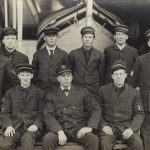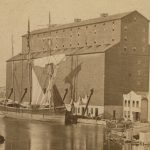A Slow Beginning
As maritime commerce grew in the early 19th century, the loss of vessels and crews to shipwreck increased. In 1848, the federal government, through the United States Revenue Marine, established its first lifesaving stations along the New Jersey coast. The system was expanded in subsequent years and reached the Great Lakes by 1854.
Keepers As, Well . . . Keepers
In the 1850s the Revenue Marine designated Wisconsin stations at Milwaukee, Sheboygan, Two Rivers, Manitowoc, Port Washington, Racine, Kenosha, and at three locations in Door County. These “stations” consisted of a cache of government-supplied equipment entrusted to a local sponsor. The crews were not paid, received little training or supervision, and did not necessarily even have a building. Nationwide, service was erratic at best. Stations were not ideally positioned, equipment fell into disrepair or went missing, and crews could not always be counted on – or sometimes even located – in an emergency.
Reorganization
In 1870 Congress finally took charge of the situation, directing the Revenue Marine to thoroughly inspect and evaluate the system. The subsequent report urged extensive improvements, including refurbishing buildings and equipment, employing full-time crews, and implementing professional standards and training. Congress approved these reforms in 1874. The same legislation authorized medals for lifesaving.

Professional at Last
Within five years of the 1875 wreck of the Tanner, the loss was credited with bringing the Lifesaving Service to Milwaukee. [1] However, this was not strictly the case. The 1874 Act had approved lifeboat stations at Milwaukee, Sheboygan, Two Rivers, and Racine, but progress was slow. The federal government had purchased a site for the Milwaukee station in July 1875, but construction had not begun when the Tanner met its fate that September. [2] Despite its largely successful outcome, the wreck of the Tanner emphasized the need for fully equipped stations on the Wisconsin coast. Stations at all four Wisconsin locations were constructed in 1876 and were first occupied by crews in the spring of 1877. [3]
Types of Stations
These first four stations were “Lifeboat Stations,” a category of installation located in populated areas and manned by presumably abundant volunteer surfmen, who were paid $3 for each drill attended. In contrast, “Lifesaving Stations,” were located in more remote places and manned by full-time crews, paid $40 per month during the eight-month season. In 1878, the U.S. Lifesaving Service became an independent agency, and additional stations were approved for Kenosha and Baileys Harbor. Twelve stations ultimately operated in Wisconsin. The Lifesaving Service was combined with the Revenue Cutter Service (formerly the Revenue Marine) in 1915 to form the United States Coast Guard, which continued to operate the stations.
Written by David Driscoll, April 2015.
FOOTNOTES
- Frank A. Flower, History of Milwaukee, Wisconsin: From Prehistoric Times to the Present Date (Chicago: Western Historical Company, 1881), 474.
- U.S. Coast Guard History Program, “Station Milwaukee, Wisconsin.” Accessed October 27, 2014. https://www.history.uscg.mil/Browse-by-Topic/Assets/Land/All/Article/2667586/station-milwaukee-wisconsin/.
- Frederick Stonehouse, Wreck Ashore: The United States Lifesaving Service on the Great Lakes (Duluth: Lake Superior Port Cities Inc., 1994), 19.
Featured image: Coast Guard Station, Sturgeon Bay, Wisconsin, c. 1915. Wisconsin Historical Society Image ID 38430.





